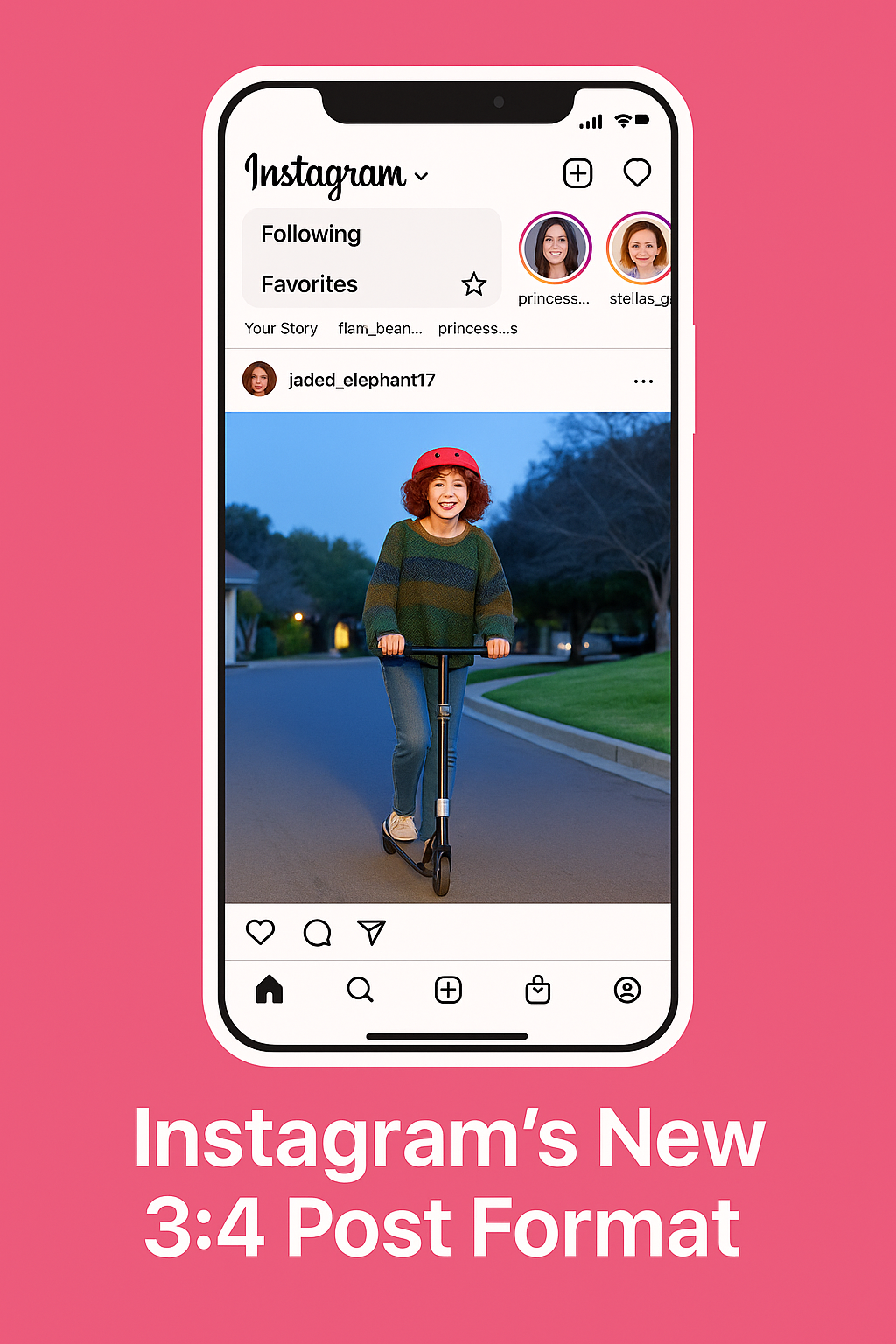
Remember the time when uploading a vertical image on Instagram felt like cramming into low-cost airline seats—squished, cropped, and humiliated?
Good news. That era is over.
In a move that could’ve saved us years of pain and pixels, Instagram has officially rolled out support for the 3:4 aspect ratio for photo uploads, both on iOS and Android. No more losing your forehead to the crop tool. No more asking, “Is it safe to post this vertical shot or will it break my grid?”
It’s vertical’s time to shine—and Instagram’s latest update is finally catching up with how we actually use our phones.
The Square Is Dead. Long Live the Rectangle.
This update means users can now natively post portrait-style photos at 1080×1440 pixels, without using hacks or third-party tools to add padding or convert them into stories or Reels.
According to Exchange4Media, Instagram’s 3:4 format rollout marks a big step forward in “offering creators flexibility in how they present their content.”
Translation? You can finally stop shrinking your masterpiece to fit into a square built for avocado toast in 2015.
As Quantifi Media puts it, the shift isn’t just aesthetic—it’s strategic.
With TikTok, Pinterest, and YouTube Shorts already optimized for vertical viewing, Instagram needed to ditch its grid-shaped nostalgia to stay relevant. Mobile-first consumption isn’t coming—it’s here.
And users are scrolling in portrait mode, not rotating their screens like it’s 2012.
Why This Matters for Everyone (Even If You Just Post Dog Pics)
For brands, this isn’t just a minor UX tweak. It’s a chance to rethink visual real estate. Vertical images occupy more screen space, which naturally boosts attention and engagement—key ingredients for conversion.
As per The Verge, the move allows images to “dominate the feed,” particularly on taller screens. That’s marketing speak for: your stuff gets noticed. Plus, with a taller frame, your storytelling canvas expands. Think: product + customer testimonial + subtle CTA—all in one scroll.
For creators, Statista shows that taller formats (like 3:4 or 9:16) are already outperforming traditional posts in save, share, and click-through metrics.
And for the rest of us? Let’s just say it’s a good day when you can post a full-length outfit shot without cropping your shoes.
3:4 vs 4:5: Wait, Aren’t We Already Doing Vertical?
You’d be right in wondering: didn’t Instagram already allow vertical-ish photos? Yes. The 4:5 aspect ratio was supported earlier (1080×1350), but it still cropped out details. The new 3:4 format (1080×1440) gives your content more height, without pushing it into the realm of Reels.
It sits in that Goldilocks zone—tall enough to be noticed, but not so tall that it looks like an ad for a mobile app.
Interestingly, Sprout Social notes this change is part of a broader content trend where users prefer “scroll-stopping visuals”—and anything that takes up more vertical space naturally does just that.
Real Talk: Does This Affect My Engagement?
In short: potentially yes.
A study by Social Insider suggests that taller images receive higher engagement on average, especially when used in combination with carousel posts. And Amber90 explains how even your profile grid will now accommodate these taller frames more fluidly—so the visual disruption is minimal, and in some cases, enhances aesthetics.
Plus, with Instagram recently tweaking how grids render across devices (Lawrence Davis), the app is clearly moving towards a mobile-first, tall-first layout strategy.
What Should You Do as a Brand/Marketer/Confused Human?
If you work in social or content, this is your cue to:
- Update your templates: Time to add 1080×1440px designs to your Canva and Figma libraries. Save that square for the museum.
- Test before you invest: Run A/B tests on 4:5 vs 3:4 visuals. See what resonates with your audience.
- Adjust CTAs: With taller space, move CTAs slightly higher to avoid being cut off in previews.
- Leverage carousels: Mix 1:1, 4:5, and 3:4 images for rhythm, retention, and scroll drama.
As Social Media Examiner notes, the key is to not just follow trends—but to understand what serves your message best.
Yes, It’s Already Everywhere
Open Instagram and scroll for 5 minutes—you’ll see the difference.
Accounts like @iamvasilenev are already using the 3:4 format to deliver dramatic shots with magazine-style framing. Brands like @themarketingexperts are optimizing the space to layer testimonials and product features within a single image. And creators? They’re breathing a collective sigh of relief that they don’t need to resize in 5 different apps before hitting “post.”
It’s also worth noting that Moneycontrol explains how the update was designed to make uploads less reliant on third-party editing and more intuitive for native phone cameras.
TL;DR
Instagram has finally added native support for 3:4 photos, and it’s about time. The change gives users and brands more flexibility, visibility, and potential engagement—especially in a content economy where vertical wins.
So yes, update your content strategy. But more importantly, stop cropping your content to fit a square box invented before TikTok was born.
Give your visuals the space they deserve.
Let them stand tall.
Footnotes
- Exchange4Media – Instagram introduces 3:4 aspect ratio
- Quantifi Media – What creators need to know
- The Verge – Why vertical formats matter
- Statista – Engagement by format
- Amber90 – Instagram grid redesign
- Sprout Social – Scroll-stopping visuals
- Social Insider – Image engagement rates
- Lawrence Davis – New grid complaints
- Social Media Examiner – Image sizes guide
- Instagram Help – Photo upload specs
- Moneycontrol – Update details and impact
